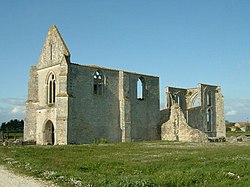Notre-Dame-de-Ré monastery
| Cistercian Abbey of Notre-Dame-de-Ré | |
|---|---|
 Les Châteliers |
|
| location |
region Nouvelle-Aquitaine Charente-Maritime |
| Coordinates: | 46 ° 11 ′ 10 ″ N , 1 ° 18 ′ 0 ″ W |
| Serial number according to Janauschek |
353 |
| Patronage | St. Mary |
| founding year | 1156? |
| Year of dissolution / annulment |
1625? |
| Mother monastery | joint establishment of L'Étoile Monastery and Trizay Monastery |
| Primary Abbey | Pontigny monastery |
|
Daughter monasteries |
no |
The Abbey of Notre-Dame-de-Ré , called Les Châteliers , is a former Cistercian monastery in the eastern part of the Île de Ré in the area of the municipality of La Flotte , which is now in ruins.
history
The abbey was founded between 1150 and 1190 with the consent of the landlord, Elbe de Mauléon , as a subsidiary of the Pontigny primary abbey . It was built near a fortress that was later destroyed. The monastery gradually became the political center of most of the island. The current ruins date from the 14th century. The monastery was destroyed for the first time by an English fleet in 1294, then rebuilt.
A second destruction took place in 1388, a third in 1462. This third incident was so serious that a new building from the ground up was necessary, especially the Notre-Dame Abbey. On November 29, 1463, Mary of Anjou , Queen of France, died in this abbey as the wife (now widow) of King Charles VII.
In 1574 the monastery was again devastated by the Huguenots and then abandoned. Stones were used to build the nearby Fort de la Prée . The rest was given to the oratorios , who converted the choir of the former church into a chapel and dedicated it to St. Lawrence. This residual monastery was closed in 1793.
The monastery now fell into complete disrepair, only the fact that it served as a landmark for shipping (the facade of the church was painted in black and white for a long time) led to occasional attempts at restoration. In 1997 the ruin was secured by the Conseil Général.
description
The abbey church
The monastery church is the best preserved part of the ruins. The type of construction dates back to the beginning of the 14th century, ie from the time after the devastation of 1294. The church has a single nave, the vault with double yoke arches has collapsed. The eaves side wall and the west facade, however, are almost intact. The nave leads to a transept, the two rungs of which contained small rectangular chapels. Only the foundations of this have been preserved, this is the least preserved part of the church. The choir used to be roofed with pointed arches, of which only remnants can be seen, which have been reinforced by recent work. This part probably dates from the 15th century and is therefore the youngest part of the structure.
The convent building
Almost nothing of these buildings has survived after their destruction and demolition in the 17th century. The cloister in the north of the church is still visible, the boundary wall was rebuilt, as was the paving of the galleries. In the middle there is a small garden. The chapter house , which adjoins the northern part of the transept and the sacristy , was not preserved, as was the sacristy itself. To the north of the monastery was the refectory , of which only a piece of the wall remains. Despite excavations, the location of the other buildings remains purely hypothetical. The finds from the excavations are exhibited in the Maison du Platin in La Flotte.
literature
- Patrick Pellereau-Deludin: L'abbaye des Châteliers. Deludin, Rochefort 1999, ISBN 2-9514146-4-1 .



